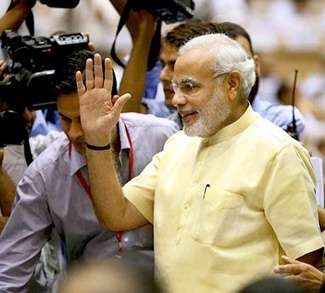Call it the “Modi bump,” “Modinomics,” or even the “Modi miracle,” it doesn’t really matter – a bullish surge by any other name is just as sweet for investors in Indian equities. Mumbai’s SENSEX index exploded on the news of a sweeping Modi victory, adding over ten percent since May 9. The spike can be attributed to two factors: Narendra Modi’s much-touted record as chief minister of Gujarat state and the decisive nature of his Bharatiya Janata Party’s (BJP) victory in national polls – with 282 seats (31% of the vote), the BJP won’t have to rely on support from regional parties, allowing a freer hand to implement what is widely seen as a pro-business policy agenda.
Modi’s victory has rekindled hope for a return to robust economic growth, hope that has been notably absent for the past few years of high inflation, fiscal largesse, and current account deficits. But, as has been proven time and time again, market sentiment inevitably gives way to economic reality. So after all the hype dies down, will Prime Minister Modi really be able to duplicate his “Gujarat miracle” on the national scale?
Looking to Modi’s Gujarat
Key to answering this question is Modi’s tenure in Gujarat, which was admittedly impressive going by many of the metrics. Gujarat ranked between first and fifth among states in urban and rural unemployment rates from 2009-2011, and its gross state product (GSP) grew at an average rate of 16.6% from 2001 to 2010. It also came fifth overall in terms of attracting FDI from 2000 to 2013. Given that Modi served as chief minister from 2001-2014, it would appear the praise is justified, and that he is a skilled administrator who knows how to attract investment and create job opportunities.
Yet gushing appraisals of Modi’s time in Gujarat should be tempered by placing the state in its proper historical context. With an extensive coastline and ample space for factories, Gujarat has always been one of India’s more entrepreneurial and business-friendly states, and its growth rates have often reflected this vis-à-vis the rest of the country. Gujarat recorded a GSP of 8.2% from 1991 to 1998, good enough to make it the fastest-growing major state before Modi even arrived. Similarly, Gujarat ranked first overall in urban unemployment in 1999.
The numbers show that Modi’s tenure in Gujarat, though impressive in its own right, does not represent an exceptional economic renaissance per se. He left Gujarat much as he found it – in pretty good shape.
One particular aspect of the Gujarat miracle that merits closer inspection is Modi’s reputation for attracting foreign investment. Two specific dealings have been referred to frequently by both supporters and detractors. One is the 2008 Tata Motors deal where Modi lured the Nano production plant from West Bengal to Gujarat, which in one fell swoop created 10,000 jobs and helped boost his state’s per-capita income. The switch occurred after local opposition from farmers in West Bengal allowed Modi to woo Tata with a package including cheap land, a new highway, and a loan at 0.01 percent interest. Another deal – one that Modi’s critics tend to focus on – involves billionaire Gautam Adani’s leasing of 7,350 acres of former grazing land at sub-market rates, land that was subsequently sublet to third-party companies at much higher rates. The land in question has been used to build India’s largest private port by volume and a coal power plant.
These two cases suggest a cozy relationship between government and corporate interests in Modi’s Gujarat. In both examples, private investment was attracted by opaque “corporate care packages” rather than a more holistically pro-business climate of good regulations, human capital, infrastructure, basic services, etc. This has commentators crying foul of the implied corporatism of the Gujarat model, with some going so far as to label it crony capitalism.
To be fair, infrastructure investment was one of Modi’s major focuses during his time as chief minister. Many of his successful projects involved private-public partnerships to develop green field sites, which did result in several new highways and rail links, but not necessarily where they were needed the most. Areas of high population density – areas where people live – were often passed over due to their relatively high construction costs.
Looking to Modi’s India
Modi will assume office against a backdrop of tepid growth, high inflation, stretched public finances, current account deficits (4.8 percent of GDP last year), and a long list of human development challenges. He will also find it harder to ‘roll out the red carpet’ for foreign investment as he did in Gujarat because major projects are generally approved on the state level.
But a red carpet was never going to be enough to rejuvenate Indian growth. For that Modi will need to make painful spending decisions and enact meaningful reform. The first budget will be a key indicator of what we can really expect from the new government. It will be revealed sometime around the first week of July, and it projects be a particularly daunting one. The outgoing Congress government pushed $16 billion in subsidy spending into this year, and there are worries that El Nino could hurt crop yields throughout the country, driving up food costs. These pressures will make it difficult for the new government to demonstrate fiscal conservatism out of the gate, so instead it may take aim at India’s byzantine regulatory apparatus by introducing a fast-track channel for the central government to streamline future infrastructure projects.
Whatever the case, Standard & Poor’s and other rating agencies will be watching the first budget very closely, and an early misstep could result in the long-threatened downgrade to junk status. There are already a few notable dissenters in the wave of euphoria sweeping India’s markets: Deutsche Bank downgraded Indian stocks to “neutral” from “neutral/overweight” on May 22, warning of possible economic pain in the short term and the pressing need for economic reform.
Conclusion
The Modi government is faced with a serious, long-term challenge if it is to realize the campaign rhetoric of a return to double-digit growth. It’s almost certain that the “Modi bump” on Indian stock markets will evaporate in the meantime as wishful thinking recedes into economic reality. This doesn’t mean that the Modi government won’t be up to the challenge of enacting a meaningful turnaround. But if and when it does, it will be the result of incremental change in the overall investment climate – some of which will come at a high political cost, afforded only on the strength of the BJP’s mandate – and not some kind of magical policy potion that was distilled during Modi’s tenure as chief minister in Gujarat.




